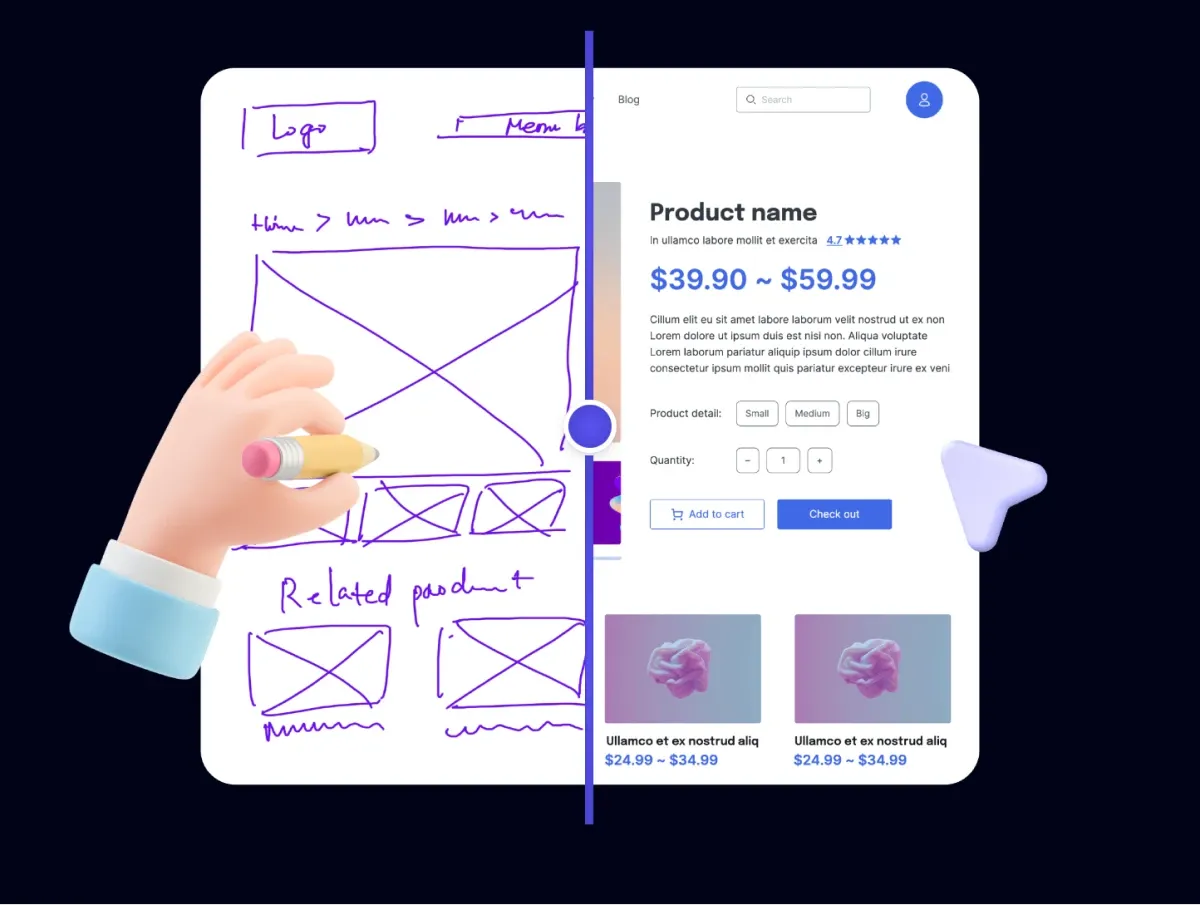Within the next few years (if not already), SaaS products that don’t have some elements of AI incorporated in them will be obsolete. Consumers expect to be able to boost their efficiency with AI in your product, and if they can’t, there are several competitors who will probably be there to greet them instead.
So it goes without saying: if layering AI into your product isn’t already on your roadmap, it definitely should be now. It helps users use your products more efficiently and get better results, quicker.
But although Artificial Intelligence is usually referred to as a blanket statement, there are actually two definitive arms that are commonly integrated into SaaS products: conversational AI and generative AI.
Each type of AI delivers a different kind of experience and comes with its own set of strengths. So how do you know which type of AI is best for your product?
Core differences in conversational AI vs. generative AI
Before we dig into the differences, we want to establish the similarities between conversational AI vs. generative AI.
Similarities between conversational and generative AI
The main similarity is that they both fall under the umbrella of Natural Language Processing (NLP), which is the field of computer science that focuses on the interactions between humans and computers through natural language.
Underneath this umbrella, both generative and conversational AI use Large Language Models (LLMs) to create their outputs. LLMs are specific tools that are built on the tenets of NLP. LLMs, like the popular GPT, Gemini, or PaLM2, are trained on huge amounts of data to learn all about language patterns, grammar, semantics, and all of the other general knowledge that it can implicitly pull from the data.
So the back end of both of these types of AI looks very similar in that they both use advanced algorithms for deep learning.
The front end of these AI tools is where they differ.
In short, generative AI is output-based, while conversational AI is interaction-based.
Conversational AI
Conversational AI’s primary focus is to simulate human interaction. These tools process, understand, and generate human-like responses, paving the way for scalable, real-time personalization in products.
Conversational AI interacts directly with users through a language-based dialogue system (i.e. chats). While the LLM’s they’re built on serve as the foundation for the algorithms, these tools continue to be trained on human interactions. That means that they can actively learn as more people interact with them.
One of the main differentiators here between how conversational AI and generative AI work is that conversational AI can implicitly pick up on a person’s intent without the explicit instruction that’s required in generative AI. Since the output is meant to closely resemble a real conversation, elements of emotional intelligence are baked in to simulate empathy and understanding.
Generative AI
The primary purpose of generative AI is to create entirely new content, such as text, video, image, or code. Many people use generative AI to create copy or graphics, analyze data, or apply predictive functionalities to their data.
The easiest way to think of generative AI, in comparison to conversational AI, is that is spits out an output that you can use, rather than conversating with you.
These AI products rely heavily upon the vast amounts of training data that they’re fed and simply use the user prompts as a jumping-off point or an indicator of when the outputs need to be altered.
These tools tend to seem “all-knowing,” since they can pull insights from their training data and nearly any publicly available website or database, depending on the model. For example, GPT-3 only uses data that is more than 2 years old, while GPT-4, the premium option, can use current data on the internet.
In comparison to conversational AI, generative AI is far more independent of the human on the other end and rather relies more on their data networks.
Best applications for generative AI in SaaS products
If you’re looking to help users quickly create content and process data in your platform, generative AI tools are going to be most helpful for you to invest in.
Speeding up creative tasks
If you have a platform that involves a lot of manual creation, this is a perfect opportunity to layer on AI so that your users can get a head start in their creative processes.
For example, you can give users the ability to automatically generate or edit copy and photos. Hubspot AI is a great example. Users have already been using Hubspot’s platform to write emails and captions, so introducing AI capabilities can help them speed up the process. Whether they want to get a first draft to work with or need some help tweaking something they’ve already created, the AI can give them a little boost. It can also help them in the ideation process.
Another more complex example is Visily, which is a wireframing platform. Product design teams have already been using their platform to kick off the design process, so they decided to integrate generative AI to make it easier for them to go from idea to design.
They offer the following options:
- Text to design
- Screenshot to design
- Text to diagram
- Sketch to design
They’re essentially using AI to cut out any of the most tedious and annoying parts of the design process and instead letting their users focus more on the creative part of the process.

Data processing + visualization
Generative AI can also make it easier for your users to interpret and visualize all of the data that they already have available in your platform.
One strong example of this is Tableau Pulse. This automates report generation and generates predictive analytics to make it easier to be more productive in their platform. This tool delivers personalized and contextualized data insights to users, anticipating their needs and suggesting relevant uses they’re not currently exploring.
Best applications for conversational AI in SaaS products
Conversational AI may not seem quite as sexy as generative AI, but it can add incredibly meaningful value to your products. Essentially, it lets you simulate and scale human interaction. This is why conversational AI is especially useful in B2B environments where deep, long-term engagements with users is the ultimate goal.
For customer support and engagement
Instead of putting all of the burden on your human support staff, conversational AI is a great way to shift some of the support operations and user troubleshooting to technology.
Our AI agent, Copilot, is a great example of this. Users are able to start a chat experience where they put natural language in and get natural language out. If they have a question about a feature in a product, if they’re having an issue with the product, or perhaps they’re just curious about something, they’re able to ask question and get immediate answers that are easy to understand.
This AI agent takes into account things like your help docs, apps connected by APIs, your website, and even user intent to generate accurate and personalized answers.
The experience feels like a chat with a real human, but on top of human-like responses, it also gives users opportunities for one-click solutions like product tours, changing feature settings, and data input.
For sales engagement + upselling
While generative AI can help you create emails to send to leads, many conversational AI tools allow “you” to actually chat with them in real-time. You’ve probably been on the receiving end of one of these before: you land on a certain page and receive a message that says “Can I help you with anything today?” or a more targeted message that’s relevant to the page you landed on or content you’ve been engaging with lately.
Conversational AI can help engage new leads immediately, nurture existing leads, and send them over to a human salesperson once they’re deemed a hot lead.
Asana’s on-site chat functionalities are a great example of this. When a visitor lands on a certain page, like the pricing or features page, the chatbot initiates a conversation asking if the visitor has any questions about the plans or specific features they’re looking at.
Let’s say a project manager lands on their website and uses the chat to learn more about their integration capabilities. The chatbot can respond with more information on the platforms they integrate with and sends them a link to a more detailed guide. This leads to an immediately more interested lead, without relying on any human interaction, meaning that lead nurture can run in the background at all times.
So which is better: conversational AI vs. generative AI?
Answering that question is like comparing apples to oranges. And it doesn’t have to be an either/or answer. Tableau, for example, uses conversational AI in its product in addition to the generative AI features we mentioned above. There likely could be opportunities to integrate both types of AI into your product to create better user experiences.
If you’re looking for a short answer for which kind of AI you should start with, we’ll boil it down to the simplest possible answer.
If you want to make it easier for users to create content and interpret data in your platform, start with generative AI.
If you want to scale human interaction and easily create more engaged power users in your product, especially if you have a product that leads to a lot of burden on your support team, you probably want to start with conversational AI.















